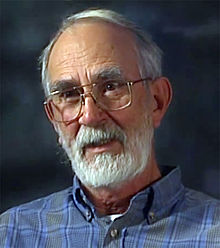Jack W. Aeby (/ˈæbi/; August 16, 1923 – June 19, 2015) was an American environmental physicist most famous for having taken the only well-exposed color photograph of the first detonation of a nuclear weapon on July 16, 1945, at the Trinity nuclear test site in New Mexico.[2][3]
Jack Aeby | |
|---|---|
 Aeby in 2003 [1] | |
| Born | Jack W. Aeby August 16, 1923 Mound City, Missouri, U.S. |
| Died | June 19, 2015 (aged 91) Española, New Mexico, U.S. |
| Occupation | Environmental physicist |
| Notable work | Trinity nuclear test color photograph |
Early life
editJack Aeby was born on August 16, 1923, in Mound City, Missouri, United States.[4]
Career
editIn 1942, Aeby joined the Manhattan Project by filling out an employment application in Albuquerque. He did a lot of jobs, including ferrying scientists and equipment between Albuquerque and Los Alamos. Though a civilian, he worked his way up into the SED (Special Engineering Detachment) in technician roles and eventually witnessed nearly 100 nuclear explosions. After getting his degree at UC Berkeley after the war, he returned, in the Health Physics Department.[5]
On July 16, 1945, Aeby took the only well-exposed color photograph of the first detonation of a nuclear weapon at the Trinity nuclear test site in New Mexico.[2][3]
While color motion pictures of the Trinity test were made, most were badly overexposed or damaged due to the fireball's tendency to blister and solarize the film. Aeby was a civilian assigned to the Physics Group 5 with Emilio Segrè and Owen Chamberlain at the time his snapshot was taken.[3]
The photo was taken with a Perfex 33 with a 35mm lens, using a shutter speed of 1/100 at f4 and Anscochrome color movie stock film.[citation needed]
Aeby was not an official observer at the test site, but was invited along to take informal photos of the work, which he had commonly done since he arrived at Los Alamos. He says he took the photos of the blast on a whim, "it was there so I shot it".[6] He took the film, a non-standard piece of Ansochrome movie stock film, out of the camera that night at a local photo lab, and worked it through the 21 step procedure for color film developing. Later on, Los Alamos management asked him if they could keep the original negative "for safe keeping". It has since been lost.[4]
Aeby says in most uses of the photo it is reversed. This was done intentionally so that the asymmetrical fireball and cloud would look the same as other official pictures taken from the north; Aeby was on the south at the Base Camp when he took the picture.[4]
Aeby is a source for a story about a notable estimate made by Enrico Fermi at that test:
As the shock wave hit Base Camp, Aeby saw Enrico Fermi with a handful of torn paper. "He was dribbling it in the air. When the shock wave came it moved the confetti." Fermi had just estimated the yield of the first nuclear explosion at the equivalent of 10,000 tons of TNT. Later measures put the yield nearly twice as much, at 18.6 kilotons. And this terrible new energy came from a plutonium ball weighing 13.6 pounds.[7]
-
Full frame of same photo
-
Jack Aeby Los Alamos badge
-
Aeby in 1944 with his Perfex 33
Personal life
editAeby lived in the Española Valley in northern New Mexico with his wife Jeanne. They had 5 children.[8] Aeby died at his home in Española in 2015.[9]
See also
edit- Berlyn Brixner – official Trinity test photographer
References
edit- ^ "Jack Aeby's Interview - Nuclear Museum". ahf.nuclearmuseum.org/. Retrieved 2023-11-22.
- ^ a b "In Memoriam: Jack Aeby". Atomic Heritage Foundation. June 23, 2015. Retrieved 24 June 2015.
- ^ a b c "NM man who took only color photo of Trinity test dies at 91". www.KOB.com. Archived from the original on 2015-06-27. Retrieved 2015-06-21.
- ^ a b c Voices of the Manhattan Project - Jack Aeby's Interview, August 2003, retrieved Feb 4, 2018
- ^ "Jack Aeby, Physicist, Los Alamos NM", Atomic Heritage Foundation, retrieved Feb 4, 2018
- ^ "The Manhattan Project, an interactive history - Trinity Color Photograph", United States Department of Energy, retrieved Feb 4, 2018
- ^ a b Calloway, Larry. "The Nuclear Age's Blinding Dawn". Albuquerque Journal. Retrieved 2015-03-20.
- ^ "Jack Aeby". Los Alamos Monitor. June 25, 2015. p. A2.
- ^ Victoria (Australia)
Further reading
edit- Jeffrey, Ian (2014). The Photography Book (2nd ed.). London: Phaidon Press. ISBN 9780714867380.
- Kelly, Cynthia C. (August 2003). "Jack Aeby's Interview". Voices of the Manhattan Project. Atomic Heritage Foundation. Retrieved 2016-08-03.
- Melnick, Aj (2006). They Changed the World: People of the Manhattan Project. Sunstone Press. pp. 14–15. ISBN 9780865345300.
- Siegel, Robert (July 15, 2005). "Photographing the Dawn of the Nuclear Age". All Things Considered (transcript). NPR. Retrieved 2015-03-20.
- "Trinity (color Photograph): Trinity Test Site (July 16, 1945)". The Manhattan Project: An Interactive History. U.S. Department of Energy- Office of History and Heritage Resources. Retrieved 2015-03-20.
External links
edit- 2003 Video Interview with Jack Aeby by Atomic Heritage Foundation Voices of the Manhattan Project
- Jack Aeby, Atom-Bomb Photographer (MP3) on NPR's All Things Considered (July 15, 2005)
- Jack Aeby exhibit Archived 2015-07-01 at the Wayback Machine at the Los Alamos Historical Museum (photos), The Los Alamos Monitor